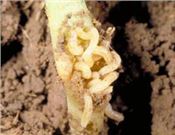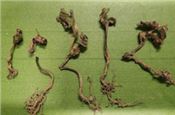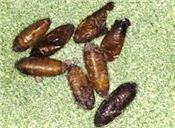Seedcorn Maggot Seen In Abundant Numbers In Corn And Soybeans
DR. RAUL VILLANUEVA
PRINCETON, KEN.
Seedcorn maggots (Figure 1) in corn and soybeans are typically observed during cool and damp seasons and in sites with organic rich soils (manure can be a source of this), including fields with reduced tillage or decaying residue from the previous season. These favorable weather conditions have been observed recently in many areas of Kentucky; there have also been emergent reports on the presence of seedcorn maggots.
Description and Habit
The seedcorn maggot is an immature form of a small fly (Delia platura). It feeds in decaying organic matter and seeds of many plants, including many vegetables, corn and soybean seeds, and seedlings. The maggot has a yellowish-white coloration (Figure 1) and can be found burrowing into seeds or emerging seedlings (Figure 2).
These maggots are legless, about 1/4 inch (6 mm) long, cylindrical, narrow, and tapered. Maggots lack heads and legs but have small black mouth hooks in front. Images from Figure 2 were received at the Research and Education Center dehydrated, but the pupa (Figure 3) found in the samples helped in the identification of the pest causing the damage. Brown pupal cases are oblong or football-shaped and are found in the soil near the roots.
Management
There are no rescue treatments for control of seedcorn maggot.
Replanting can be an option; however, the decision to replant should be based on plant population densities in the field, the date of occurrence, and yield expectation. ∆
DR. RAUL VILLANUEVA: Extension Entomologist, University of Kentucky

Figure 1. Seedcorn maggots on broccoli seedling and their damage
Photo: Ric Bessin, UK

Figure 2. Dehydrated soybean samples showing damages caused by seedcorn maggots
Photo: Raul Villanueva, UK

Figure 3. Pupae of seedcorn maggots approximately 5-mm long
Photo: Raul Villanueva, UK
(Left) Figure 2. Dehydrated
soybean samples showing
damages caused
by seedcorn maggots
Photo: Raul Villanueva, UK